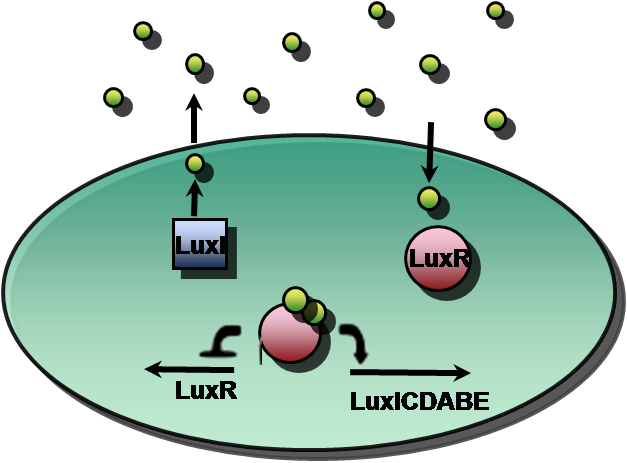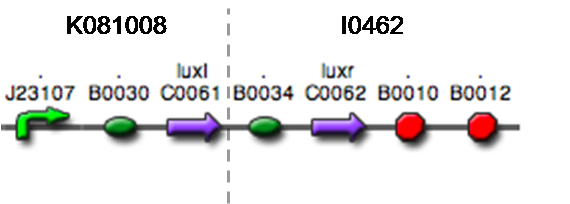Team:Aberdeen Scotland/WetLab/quorumsensing
From 2009.igem.org
University of Aberdeen - Pico Plumber
Quorum Sensing Intro
An important design requirement for our project was that our picoplumber must possess the ability to detect a quorum; our e.coli should be able sense other cells in the surrounding environment, so that self-lysis is triggered only once a threshold population density is reached. This is important as it ensures that lysis only occurs at a breach point, and hence, avoids possible obstruction due to release of sticky proteins into the main pipe area. To satisfy this remit, we designed a quorum sensing module, based upon the lux system from the marine bacterium vibrio fischeri.
Quorum sensing is a method of bacterial communication and allows the co-ordination of gene expression in response to fluctuations in cell density. This enables populations of cells to control a diverse array of biological processes in synchrony, from biofilm formation to bioluminescence (Miller et al, 2001). In order to quorum sense individual cells produce and respond to small signalling molecules, termed autoinducers, that accumulate in the cell’s external environment (Surette et al, 1999). The concentration of autoinducer increases, both intra and extra-cellularly, with increasing cell density and once a minimal threshold concentration is reached, gene expression is altered (Miller et al, 2001).
Many bacteria monitor population density in this way, including the marine bacterium vibrio fischeri. This particular bacterium possesses two quorum sensing systems, ain and lux; both systems use acyl homoserine lactones (AHLs) as signalling molecules (Lupp et al, 2005). In the lux system, synthesis of AHL is directed by the product of the LuxI gene, using the substrates S-adenosylmethionine and acylated acyl protein (SAM and ACP) (Schaeffer et al, 1996). Once a critical concentration of AHL is reached, it associates with the transcriptional activator, LuxR, to regulate transcription of the Luminescence (lux) operon (Callahan et al, 2000). This can be seen below:
Figure 1: The Vibrio fischeri Lux quorum sensing circuit, consisting of five luciferase genes (luxCDABE) and two regulatory genes (luxI and luxR).
As can be seen from the diagram above, the luxR-autoinducer complex binds to both the left and right promoters of the lux system. This represses expression of luxR and activates expression of the LuxICDABE genes, respectively. The result is an exponential increase in autoinducer, through increased expression of luxI, and and an exponential increase in light emission, through increased transcription of LuxCDABE (Miller et al, 2001).
Aim
As aforementioned, our aim was to design a quorum sensing module based upon the lux system from vibrio fischeri. We utilised the genes LuxI, encoding an AHL synthase, and LuxR, encoding a transcriptional activator, using the biobricks BBa_K081009 and BBa_I0462 respectively. This can be seen below:
References
Surette M.G., Miller M.B. and Bassler B.L. (1999). Quorum Sensing in Escherichia coli, Salmonella typhimurium and vibrio harveyi: a new family of genes responsible for autoinducer production. Proc Natl Acad Sci USA. 96(4):1639-16144
Miller M.B and Bassler B.L (2001). Quorum Sensing in bacteria. Annu. Rev. Microbiol. 55: 165-199
Schaefer A.L, Val D.L, Hanzelka B.L, Cronan J.E, Jr, and Greenberg E.P (1996). Generation of cell-to-cell signals in quorum sensing: acyl homoserine lactone synthase activity of a purified vibrio.fischeri LuxI protein. Proc Natl Acad Sci USA. 93(18): 9505-9509
Callahan S.M and Dunlap P.V. (2000) LuxR- and Acyl-Homoserine-Lactone-Controlled Non-lux Genes Define a Quorum-Sensing Regulon in Vibrio fischeri. Journal of Bacteriology. 182(10): 2811-2822 Lupp C. and Ruby E.G. (2005) Vibrio fischeri Uses Two Quorum-Sensing Systems for the Regulation of Early and Late Colonization Factors. Journal of Bacteriology. 187(11): 3620-3629.
 Back to LacI-Latch Results Back to LacI-Latch Results
|
Continue to Cloning Strategy 
|
 "
"

